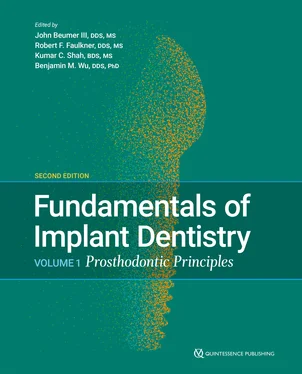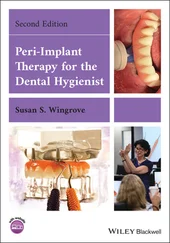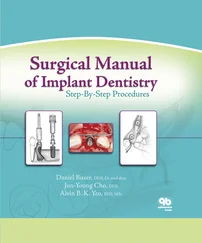Optical scanning technologies
Over a dozen scanning technologies are commercially available for IOSs. Regardless of the core scanning mechanism, all scanners project light onto a target, record the image, analyze the data, and define the 3D coordinate of each point within the scan target zone. By keeping track of the camera movement via integrated accelerometers, actual target topology can be compared against camera motion to generate a digital 3D mesh that can be rendered, displayed, and converted into common 3D file formats. A detailed engineering review of each scanning technology is beyond the scope of this chapter, but this section provides brief summaries of select scanning technologies to illustrate the relationship between scanning mechanisms and their impact on clinical applications. Other systems are described in other outstanding reviews. 25
Several scanners rely on a confocal laser that records the x, y, and z coordinates by passing a light source through a pinhole aperture and bending the dispersed light with an optical lens onto the target (eg, Chairside Economical Restoration of Esthetic Ceramics [CEREC]). 26, 27Due to light dispersion through the aperture, only a small area on the target will be in sharp focus, and all other neighboring points are out of focus. By collecting the coordinates of the sharp, in-focus points and discarding all out-of-focus coordinates, the neighboring points are connected to form triangles, and adjoining triangles are connected to produce a mesh (triangulation) to represent the surface of the object. This is why most scanned files appear hollow when they are flipped upside down. The earlier versions of confocal laser intraoral scanners utilized infrared light (700–1,000 nm), which has been replaced with blue light (eg, CEREC BlueCam) because the shorter wavelength (450–485 nm) reduces distortion and increases accuracy. A major disadvantage of the basic confocal laser approach is that accurate triangulation requires uniform surface in terms of light absorption, reflection, opacity, and moisture content. Because intraoral materials such as enamel, root dentin, soft tissues, polymers, ceramics, and metals have very different optical properties, it was critical to coat all surfaces to be scanned with a thin layer of powder to confer uniform optical behavior of all surfaces.
Compared to confocal imaging, a relatively recent imaging technique called active wavefront sampling (AWS) was developed at the Massachusetts Institute of Technology. 28Commercially known as 3D-in-Motion, AWS is used in IOSs such as the Lava Chairside Oral Scanner (3M) and the True Definition Scanner (3M), where an optical wavefront of reflected images from scan targets (eg, teeth or scan body) travel through multiple rotating apertures and a series of optical lenses, toward image sensors that capture the images. The rotating apertures and lens system create image disparity, and the amount of blurring depends on the distance between target and camera. If the target distance matches the focal length of the lens, a sharp image is captured with minimum blurring. For all other target surfaces, their exact distance can be calculated from the amount of blurring. By moving the camera over the teeth, the x-y-z coordinates are used to reconstruct the data into surface mesh very rapidly. Although confocal laser scanning and AWS are adequate for clinical use, the requirement for titania powder coating is a significant disadvantage. Besides adding clinical time for spraying and removal, controlling a uniform thickness of spray powder presents a new source of error.
One powder-free imaging technique is parallel confocal scanning (iTero, Align Technology), which directs a white light source through a spinning color wheel to generate an array of focused beams in three different color wavelengths (450–485 nm for blue, 520–560 nm for green, and 635–700 nm for red). The light intensity of the reflected pattern in each color is used to calculate the distance without the need for powder. 29Furthermore, by combining the images captured at specific wavelengths, color information is captured at each point of the surface mesh and rendered as a full-color scan. By adding a fourth light source in the near-infrared (NIR) spectrum (0.7–1.1 µm) and an NIR detector, it can also detect interproximal caries lesions. While the color wheel increases the size and weight of the scan head, this approach is already smaller and less expensive than alternatives such as adding multiple light sources or moving the wheel farther away from the camera. The slightly larger head is potentially a concern when mouth openings are limited or when the camera needs to be rotated in the posterior areas to capture deep preparation margins that have restricted line of sight.
Another variant of confocal scanning operates by oscillating the optical subsystem to modulate the focal plane (TRIOS, 3Shape). By imaging target points over time, the target appears in and out of focus as the focal plane changes internally. The amount of blur and the focal plane location is used to calculate target distance very rapidly in order to reconstruct 3D surface mesh without the need for powder. By adding color beams and NIR, the system can add fully colored renderings and interproximal caries detection.
Another powder-free scanning technology is based on optical coherence tomography (OCT) used in many medical imaging applications. Analogous to ultrasound imaging, OCT conducts high-resolution, cross-sectional imaging by quantifying the intensity and delay time of the reflected light due to optical interference. 30In its most basic form, time domain OCT (TD-OCT) uses an interferometer to split a low- coherence light source into reference and sample beams. The reference beam is reflected by a mirror, and this reflected beam travels backward along the same path within the interferometer as the initial reference beam. Simultaneously, the sample beam is reflected by the target surface. The two reflected beams generate an interference pattern that depends on the delay time and intensity of the reflected sample beam as well as the distance of the reference mirror. As micromotors move the mirror back and forth, the topology-depth-dependent sample reflection can be determined accurately to locate the surface points by analyzing the interference patterns. Because the transit time of the translating mirror limits scan speed, IOSs such as E4D Technologies deploy a more advanced strategy called swept source OCT (SS-OCT) that sweeps a narrow spectral line across the spectral range of a broadband light source. 31To achieve this, SS-OCT replaces the translating mirror with vibrating mirrors at 20,000 Hz, upgrades light sources to high-speed tunable broadband lasers, and replaces monochromatic sensors with spectrometric detectors. The collection of target-backscattered light from the entire spectral range is treated as modulations in the source spectrum, and the target distance is calculated accordingly using proprietary mathematical algorithms. 32Besides increasing scan speed by approximately 100-fold over TD-OCT, SS-OCT also captures at higher imaging resolution and signal-to-noise ratio. The reliance on spatial positioning means that clinically, a rubber insert is added to the camera head to maintain near-constant distance between the camera and the target. However, more engineering optimization may be necessary as SS-OCT was reportedly less accurate than other scanning technologies for full-arch scanning. 33Full-arch scanning is an important clinical issue, as discussed later.
Regardless of scanning technology, most of the current commercially available IOSs can produce reasonably accurate single-tooth restorations in terms of general accuracy as defined by international standards. 34They are adequate for most short-span prostheses (ie, fewer than 4 to 5 units) such as fixed partial dentures and surgical guides for implants and endodontics. Currently, full-arch scanning is limited to fully dentate applications such as orthodontic aligners and bracket trays, occlusal guards, snore appliances, and full-mouth reconstruction comprised of single units and short edentulous segments. No IOS has been shown to be adequate for accurate, simultaneous capture of implant coordinates and soft tissue contours when long edentulous spans are present. One study found that although digital impressions may offer less variability (higher precision), conventional impressions yielded significantly greater accuracy for in vivo full-arch impressions. 35A recent study using laboratory gypsum models instead of intraoral scanning confirmed that even the latest generation of IOSs are less accurate when scanning a fully edentulous gypsum model with six polyetheretherketone (PEEK) scan bodies, relative to scanning a partially edentulous gypsum model with three PEEK scan bodies spanning four teeth. The error in trueness (actual spatial coordinates) for full-arch scanning was found to be as high as 170% that of quadrant scanning, and the error in precision (reproducibility) for full-arch scanning was found to be up to 386% that of quadrant scanning. 36While some scanners performed better than others, all suffered significant performance degradation when full-arch scanning is performed.
Читать дальше












